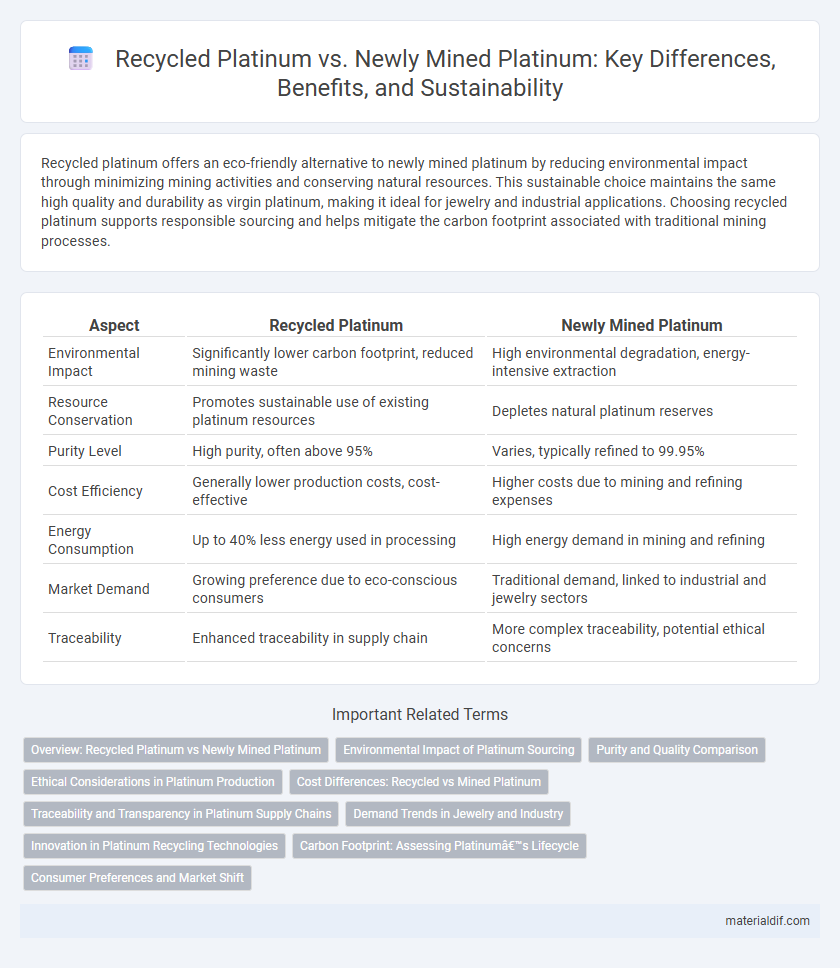Recycled platinum offers an eco-friendly alternative to newly mined platinum by reducing environmental impact through minimizing mining activities and conserving natural resources. This sustainable choice maintains the same high quality and durability as virgin platinum, making it ideal for jewelry and industrial applications. Choosing recycled platinum supports responsible sourcing and helps mitigate the carbon footprint associated with traditional mining processes.
Table of Comparison
| Aspect | Recycled Platinum | Newly Mined Platinum |
|---|---|---|
| Environmental Impact | Significantly lower carbon footprint, reduced mining waste | High environmental degradation, energy-intensive extraction |
| Resource Conservation | Promotes sustainable use of existing platinum resources | Depletes natural platinum reserves |
| Purity Level | High purity, often above 95% | Varies, typically refined to 99.95% |
| Cost Efficiency | Generally lower production costs, cost-effective | Higher costs due to mining and refining expenses |
| Energy Consumption | Up to 40% less energy used in processing | High energy demand in mining and refining |
| Market Demand | Growing preference due to eco-conscious consumers | Traditional demand, linked to industrial and jewelry sectors |
| Traceability | Enhanced traceability in supply chain | More complex traceability, potential ethical concerns |
Overview: Recycled Platinum vs Newly Mined Platinum
Recycled platinum offers a sustainable alternative to newly mined platinum by significantly reducing environmental impact through decreased mining activity and energy consumption. Newly mined platinum, while essential for meeting global industrial and jewelry demand, involves intensive extraction processes that contribute to habitat disruption and carbon emissions. The balance between recycled and newly mined platinum is crucial for supporting supply chain sustainability and minimizing ecological footprint in platinum production.
Environmental Impact of Platinum Sourcing
Recycled platinum significantly reduces environmental impact by lowering the need for energy-intensive mining processes, which often result in habitat destruction, water pollution, and high carbon emissions. Newly mined platinum extraction consumes more resources and causes greater ecological disruption, contributing to soil erosion and biodiversity loss. Using recycled platinum supports sustainable practices by minimizing waste and decreasing overall environmental footprint linked to precious metal sourcing.
Purity and Quality Comparison
Recycled platinum maintains purity levels comparable to newly mined platinum, typically reaching 95-99.9% pure after refined processing. Quality remains consistent during recycling due to advanced purification techniques that remove contaminants without degrading the metal's intrinsic properties. Both recycled and newly mined platinum meet industry standards for use in high-precision applications such as jewelry and catalytic converters.
Ethical Considerations in Platinum Production
Recycled platinum significantly reduces environmental impact by minimizing the need for new mining, which often involves habitat destruction, high energy consumption, and harmful chemicals. Ethical considerations favor recycled platinum due to lower carbon footprints and improved labor conditions compared to newly mined platinum, which is frequently associated with labor exploitation and conflict zones. Choosing recycled platinum supports sustainable practices and promotes responsible sourcing within the platinum supply chain.
Cost Differences: Recycled vs Mined Platinum
Recycled platinum typically costs 20-30% less than newly mined platinum due to reduced extraction and refining expenses. The price advantage stems from lower energy consumption and minimized environmental impact during recycling processes. Market volatility in mined platinum prices also makes recycled platinum a more stable and cost-effective option for manufacturers.
Traceability and Transparency in Platinum Supply Chains
Recycled platinum offers superior traceability and transparency compared to newly mined platinum, as its origins are more easily documented through established recycling processes. Supply chain transparency is enhanced by digital tracking technologies such as blockchain, ensuring recycled platinum's ethical sourcing and reducing environmental impact. Mining activities often face challenges in verifying ethical standards, making recycled platinum a more reliable choice for consumers demanding accountable and sustainable supply chains.
Demand Trends in Jewelry and Industry
Recycled platinum accounts for approximately 30% of global supply, driven by rising demand in jewelry markets seeking sustainable and ethical sources. Newly mined platinum remains essential to industrial applications, particularly in automotive catalytic converters and electronics, where material purity and availability are critical. Growth in green technologies and tighter global emissions regulations are expected to increase demand for both recycled and newly mined platinum across multiple sectors.
Innovation in Platinum Recycling Technologies
Innovations in platinum recycling technologies have significantly increased the recovery rate of recycled platinum, reducing reliance on newly mined sources. Advanced chemical processes and automated sorting systems enable efficient extraction of platinum from electronic waste, catalytic converters, and industrial by-products. These technological advancements not only lower environmental impact but also contribute to supply chain sustainability in the platinum market.
Carbon Footprint: Assessing Platinum’s Lifecycle
Recycled platinum significantly reduces carbon emissions by avoiding the energy-intensive extraction processes required for newly mined platinum, which can emit up to 40 tons of CO2 per kilogram. Lifecycle assessments reveal recycled platinum lowers environmental impact by leveraging existing materials, minimizing waste, and conserving natural resources. This carbon footprint advantage supports sustainable practices crucial to the platinum supply chain and global climate goals.
Consumer Preferences and Market Shift
Consumer preferences increasingly favor recycled platinum due to its environmental sustainability and lower carbon footprint compared to newly mined platinum, aligning with growing ethical consumption trends. Market data reveals a significant shift as jewelry brands and industrial buyers seek recycled sources to reduce ecological impact and comply with stricter regulations on mining practices. This transition boosts demand for recycled platinum, driving innovation in refining technologies and creating a more circular supply chain within the global platinum market.
Recycled Platinum vs Newly Mined Platinum Infographic

 materialdif.com
materialdif.com